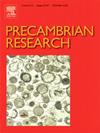The Tonian sedimentary records in the southwestern West Qinling orogen, central China, reveal an active margin setting
IF 3.2
2区 地球科学
Q2 GEOSCIENCES, MULTIDISCIPLINARY
引用次数: 0
Abstract
Neoproterozoic geological records are uncommon in the West Qinling orogen (central China), restricting a clear understanding of its early evolution and the relationships between the West Qinling terrane and surrounding blocks in the Neoproterozoic. The infrequent Neoproterozoic sedimentary successions in the southwestern West Qinling orogen, named as the Baiyigou Group, may provide important insights into these issues. In this contribution, we present comprehensive analysis results, including sedimentological, petrographic, heavy mineral, zircon U-Pb-Hf isotopic and trace element, and whole-rock element geochemical data from Baiyigou Group samples, to determine their depositional ages, provenance and tectono-sedimentary settings. The Baiyigou Group is characterized by mixed volcaniclastic and siliciclastic deposits. Zircon U-Pb dating results from seven tuffaceous sandstones show overwhelming Tonian ages (ca. 840–780 Ma), with major age peaks at the range of ca. 820–800 Ma. Three granite gravel samples from conglomerate strata show crystallization ages at ca. 809–802 Ma, providing maximum depositional age constraints. All these geochronological data indicate that the Baiyigou Group succession accumulated during the middle–late Tonian (ca. 820–800 Ma for the Saiyikuo Formation and possibly largest duration of ca. 800–720 Ma for the overlying Xianglongka Formation). Tephra-rich sandstones are poorly sorted and are featured by abundant embayed grains, whereas tephra-free sandstones are moderate-well sorted and are rich in detrital feldspar grains. Several heavy mineral samples indicate extremely high zircon contents and most zircon grains are texturally euhedral, representing first-cycle detritus. We propose that this sedimentary system was dominantly fed by intermediate-acid igneous rocks from localized source terranes with small drainage networks and was also contributed by extensive wind-carried volcanic clasts. Our petrographic, whole-rock geochemical and zircon trace element data reveal a continental arc setting for the sedimentary sources during the middle–late Tonian. We suggest that the middle–late Tonian West Qinling terrane was in an active margin setting, being involved in the long-lived subduction-related system along the western margin of the Yangtze Block. These findings are crucial to a better understanding of the Neoproterozoic tectono-sedimentary settings of the central China micro-terranes along with the Rodinia supercontinent evolution.
求助全文
约1分钟内获得全文
求助全文
来源期刊

Precambrian Research
地学-地球科学综合
CiteScore
7.20
自引率
28.90%
发文量
325
审稿时长
12 months
期刊介绍:
Precambrian Research publishes studies on all aspects of the early stages of the composition, structure and evolution of the Earth and its planetary neighbours. With a focus on process-oriented and comparative studies, it covers, but is not restricted to, subjects such as:
(1) Chemical, biological, biochemical and cosmochemical evolution; the origin of life; the evolution of the oceans and atmosphere; the early fossil record; palaeobiology;
(2) Geochronology and isotope and elemental geochemistry;
(3) Precambrian mineral deposits;
(4) Geophysical aspects of the early Earth and Precambrian terrains;
(5) Nature, formation and evolution of the Precambrian lithosphere and mantle including magmatic, depositional, metamorphic and tectonic processes.
In addition, the editors particularly welcome integrated process-oriented studies that involve a combination of the above fields and comparative studies that demonstrate the effect of Precambrian evolution on Phanerozoic earth system processes.
Regional and localised studies of Precambrian phenomena are considered appropriate only when the detail and quality allow illustration of a wider process, or when significant gaps in basic knowledge of a particular area can be filled.
 求助内容:
求助内容: 应助结果提醒方式:
应助结果提醒方式:


